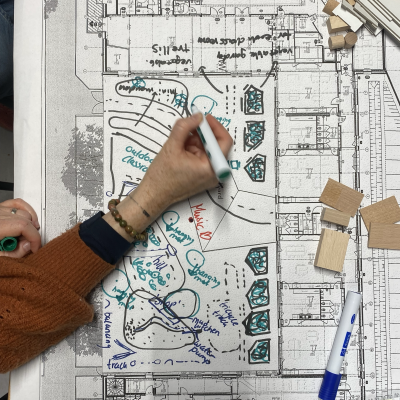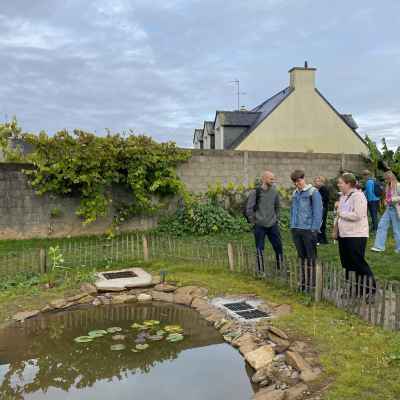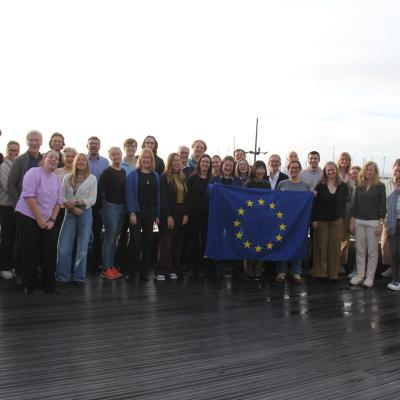From Brest’s schoolyards to Europe’s cities: the Biodiverse Cities partners gathered in Brest for the 7th partner meeting to learn from the innovative strategies the city is putting into practice, deepen cross-city collaboration, and help each other move into the next phase of the Biodiverse Cities pilot process as the project moves towards its final year.
The Biodiverse Cities project brings together five pilot cities from Europe’s North Sea region to develop, test and implement Nature-based Solutions (NbS) that restore local ecosystems and halt biodiversity loss. These solutions are then adapted and replicated in three additional ‘pollinator cities’ across the region, helping to scale effective approaches and deepen collective learning.
As one of the project’s pollinator cities, Brest hosted the 7th Biodiverse Cities partner meeting from 22–24 October 2025. The event provided an opportunity for the city to showcase the innovative strategies it is deploying to address its unique environmental context, while also creating a shared space for partners to work side by side - exchanging lessons from both successes and setbacks, strengthening cross-city collaboration, and helping each other to accelerate progress on each of their Biodiverse Cities pilot sites.
Brest: The Metropolis of the Ocean
Known as Europe’s ‘Metropolis of the Ocean’, Brest has long combined ambitious plans for economic development with strong environmental and educational agendas. In recent years, climate adaptation has become an increasing priority for the coastal city, where intensifying rainfall poses both challenges and opportunities. Currently, only around half of Brest’s rainwater infiltrates the ground, while the rest creates flooding risks. By 2050, extreme rainfall events are projected to occur every seven years, highlighting the urgency of introducing nature-based approaches to water management.
A key cornerstone of Brest’s strategy to address these challenges lies in citizen engagement. Brest’s participation in Biodiverse Cities builds naturally on this longstanding approach, integrating its educational and participatory ethos into the broader project framework.
Engaging Brest’s youngest citizens in the pilot co-design process
Education and child participation are central to Brest’s urban strategy and feed into a wider national dialogue in France around reintegrating children into public spaces and prioritising child-friendly urban design. This philosophy also underpins Brest’s involvement in the Biodiverse Cities project, with its chosen pilot site focused on greening the Langevin-Freinet schoolyard.
During the meeting, partners were able to see the implemented site, where 50% of the surface area has been desealed and greened, 18 trees planted, and a new pond installed to capture rainwater for reuse. These developments are already benefitting 225 children, with the Brest team sharing that the changes have been met with great enthusiasm from both pupils and teachers.
This collective enthusiasm stems in large part from the participatory approach that underpins the Langevin-Freinet pilot, as well as other connected schoolyard greening initiatives being carried out by the Brest team. 150 children were consulted to gather key insights into how they perceive and use their city, the barriers that prevent them from fully enjoying its public spaces, and their ideas for what a more child-friendly city might look like. Among the most consistent messages shared by the children was a desire for a greener environment, richer in animal and plant life. This message is being directly translated into action at the Langevin-Freinet pilot site, and at other schoolyards across the city which partners were also able to visit during the meeting.
The visit to the Langevin-Freinet site also highlighted the replication and inspiration potential that lies at the heart of the Biodiverse Cities project. The Brest team reflected on how they drew inspiration from presentations by Aarhus University early in the project, particularly on the theme of biodiversity in design, incorporating these ideas into their final schoolyard plans where they helped inform their choice of soil typologies, plant heights, and the integration of vegetation, minerals, and water. The success and learnings from the Langevin-Freinet pilot site have also directly fed into the NbS now being implemented at connected schoolyard greening projects across Brest.
Collaboration, Co-creation, Replication
The spirit of co-design was a core theme throughout the Brest meeting, reflecting one of the project’s guiding principles: learning with and from one another. Alongside the city representatives, the project’s knowledge partners - leading experts in ecology, ecosystem services, conservation, community engagement, co-creation, and governance - played a vital role in facilitating dialogue and sharing evidence-based insights.
Aeres University led a Transnational Peer Learning (TNPL) workshop on leverage points, helping cities identify the strategies that could bring their biodiversity visions to life. Open Kaart and Bremen University, meanwhile, facilitated sessions on citizen engagement, exploring creative and inclusive models for involving communities in biodiversity action. A dedicated City Consultation session brought together all Knowledge Partners and city representatives in a rotational exchange format, strengthening collaboration and aligning upcoming outputs across the partnership.
Moving Forward: The Biodiversity Action Plan
The final day of the Brest partner meeting focused on continuing work on each of the city’s Biodiversity Action Plans, translating shared learning into concrete action. Facilitated by Dordrecht, Aeres University and Bax, the workshop guided cities in turning ideas into tangible local roadmaps. Discussions centred on governance, data integration, and cross-departmental coordination - essential ingredients for embedding biodiversity into urban policy and planning.
As the project moves toward its final year, the Brest meeting provided renewed energy and focus. It strengthened transnational collaboration, deepened partners’ understanding of how to mainstream biodiversity in urban contexts, and reaffirmed the collective ambition of building more resilient, nature-inclusive cities across Europe’s North Sea region.




